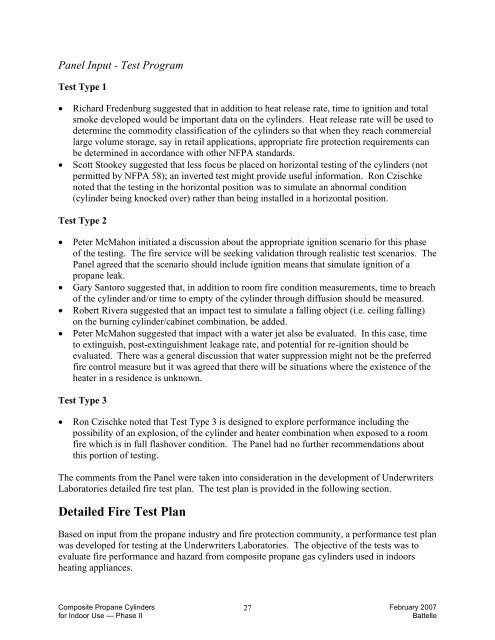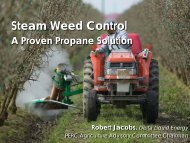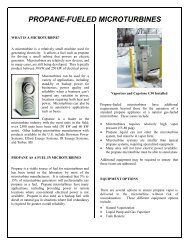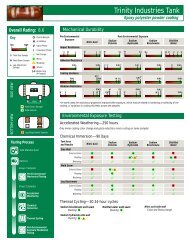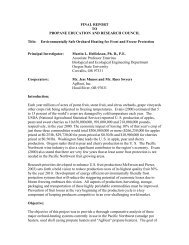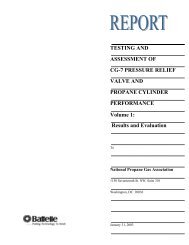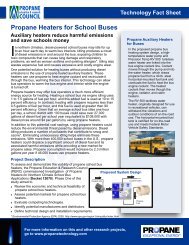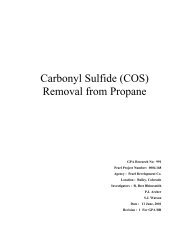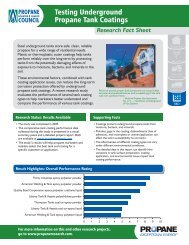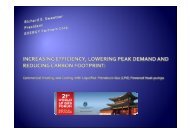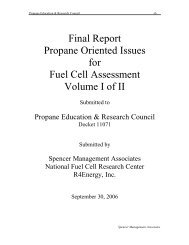Code Approval of Composite Propane Cylinders for Indoor Use ...
Code Approval of Composite Propane Cylinders for Indoor Use ...
Code Approval of Composite Propane Cylinders for Indoor Use ...
You also want an ePaper? Increase the reach of your titles
YUMPU automatically turns print PDFs into web optimized ePapers that Google loves.
Panel Input - Test ProgramTest Type 1• Richard Fredenburg suggested that in addition to heat release rate, time to ignition and totalsmoke developed would be important data on the cylinders. Heat release rate will be used todetermine the commodity classification <strong>of</strong> the cylinders so that when they reach commerciallarge volume storage, say in retail applications, appropriate fire protection requirements canbe determined in accordance with other NFPA standards.• Scott Stookey suggested that less focus be placed on horizontal testing <strong>of</strong> the cylinders (notpermitted by NFPA 58); an inverted test might provide useful in<strong>for</strong>mation. Ron Czischkenoted that the testing in the horizontal position was to simulate an abnormal condition(cylinder being knocked over) rather than being installed in a horizontal position.Test Type 2• Peter McMahon initiated a discussion about the appropriate ignition scenario <strong>for</strong> this phase<strong>of</strong> the testing. The fire service will be seeking validation through realistic test scenarios. ThePanel agreed that the scenario should include ignition means that simulate ignition <strong>of</strong> apropane leak.• Gary Santoro suggested that, in addition to room fire condition measurements, time to breach<strong>of</strong> the cylinder and/or time to empty <strong>of</strong> the cylinder through diffusion should be measured.• Robert Rivera suggested that an impact test to simulate a falling object (i.e. ceiling falling)on the burning cylinder/cabinet combination, be added.• Peter McMahon suggested that impact with a water jet also be evaluated. In this case, timeto extinguish, post-extinguishment leakage rate, and potential <strong>for</strong> re-ignition should beevaluated. There was a general discussion that water suppression might not be the preferredfire control measure but it was agreed that there will be situations where the existence <strong>of</strong> theheater in a residence is unknown.Test Type 3• Ron Czischke noted that Test Type 3 is designed to explore per<strong>for</strong>mance including thepossibility <strong>of</strong> an explosion, <strong>of</strong> the cylinder and heater combination when exposed to a roomfire which is in full flashover condition. The Panel had no further recommendations aboutthis portion <strong>of</strong> testing.The comments from the Panel were taken into consideration in the development <strong>of</strong> UnderwritersLaboratories detailed fire test plan. The test plan is provided in the following section.Detailed Fire Test PlanBased on input from the propane industry and fire protection community, a per<strong>for</strong>mance test planwas developed <strong>for</strong> testing at the Underwriters Laboratories. The objective <strong>of</strong> the tests was toevaluate fire per<strong>for</strong>mance and hazard from composite propane gas cylinders used in indoorsheating appliances.<strong>Composite</strong> <strong>Propane</strong> <strong>Cylinders</strong> 27February 2007<strong>for</strong> <strong>Indoor</strong> <strong>Use</strong> — Phase IIBattelle


